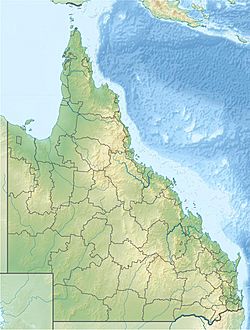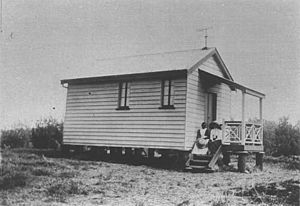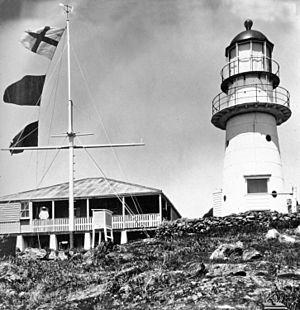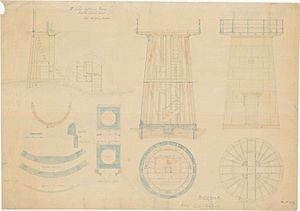Double Island Point Light facts for kids
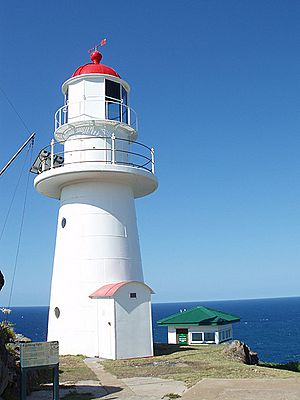 |
|
| Double Island Point Light, 2006 | |
|
|
|
| Location | Double Island Point, Cooloola, Gympie Region, Queensland, Australia |
|---|---|
| Coordinates | 25°55′54.3″S 153°11′26.4″E / 25.931750°S 153.190667°E |
| Year first constructed | 1884 |
| Construction | timber frame clad with galvanized iron |
| Tower shape | conical tower with double gallery and lantern |
| Markings / pattern | white tower and lantern, red lantern dome |
| Height | 39 feet (12 m) |
| Focal height | 315 feet (96 m) |
| Current lens | VRB-25 |
| Intensity | 48,430 cd |
| Range | 17 nautical miles (31 km; 20 mi) |
| Characteristic | Fl W 7.5s. |
| Admiralty number | K2912 |
| NGA number | 111-5660 |
| ARLHS number | AUS-065 |
The Double Island Point Light is a working lighthouse located at the very top of Double Island Point. This is a coastal area inside the Great Sandy National Park in Queensland, Australia. It stands at the southern end of Wide Bay, about 70 kilometres (43 mi) north of Noosa Heads.
Even though people suggested building a lighthouse here in 1864, it wasn't built until 1884. A man named W. P. Clark, who built other lighthouses in Queensland, constructed it. Over the years, the light was improved many times. It started with kerosene, then changed to electricity, and finally to solar power in 1991. The lighthouse became automatic in 1992, meaning it no longer needed people to operate it all the time.
This lighthouse looks like many others in Queensland. It's made from a timber frame covered with galvanized iron plates, which are painted white. The top part, called the lantern dome, is red. Inside, it has a modern VRB-25 light that spins around. The lighthouse is surrounded by other small buildings, including two cottages where the lighthouse keepers used to live. The area is part of a national park, but you can't go inside the lighthouse itself.
Contents
History of the Lighthouse
Queensland became its own colony in 1859. In 1862, the government chose Commander George Poynter Heath as the first Portmaster. His job was to manage the ports and shipping. In 1864, two groups were formed to decide where to build lighthouses along the coast. Double Island Point was one of the places they thought would be good for a lighthouse. However, it took almost 20 years for the government to act on this idea.
Around 1881 or 1882, Heath told the Parliament that a lighthouse was really needed at Double Island Point. In 1883, he visited the point and realized that the original plan to build the lighthouse halfway up the hill wouldn't work. The light wouldn't be seen well from the north. So, he suggested building it at the very top of the point. He also recommended using a more powerful light than first planned, and his advice was accepted.
Plans were drawn up by the Queensland Colonial Architect's Office. By June 1883, they asked companies to bid on building the lighthouse and the homes for the lighthouse keepers. The contract for both Double Island Point and another light station was given to W. P. Clark. He had already built several other lighthouses in Queensland, including Bustard Head Light and Low Isles Light.
The Double Island Point Light first shone on September 11, 1884. It was the 18th lighthouse built by the Queensland Government. The first lamp used oil and produced a light of 13,000 candela (a measure of brightness). It was a steady light with panels that spun around. Three cottages for the lighthouse keepers were also built near the lighthouse. A schoolhouse was set up at the point at the same time, which stayed open until 1922.
In 1923, the light was upgraded. It started using vaporized kerosene with a special mantle, making it much brighter at 100,000 candela. Another upgrade in 1925 replaced the lens with a new, larger one that floated in a mercury bath, allowing it to spin smoothly. In 1933, the light was changed to run on electricity, making it incredibly bright at 750,000 candela. The old cottages were taken down, and two new, more modern ones were built further down the hill, where the old schoolhouse used to be. A new watch hut was also added.
In 1961, the radio equipment was moved from the lighthouse area to a new radio hut near the cottages. This hut is now used for weather observations. In 1980, a new building was constructed to hold two diesel engines, and large fuel tanks were installed. At this time, the light was changed to use 240 Volt AC electricity. The light source became a 120 Volt, 1000 Watt tungsten halogen lamp, which was very powerful at 1,000,000 candela. This light could be seen for 26 nautical miles (48 km; 30 mi) (nautical miles).
The lighthouse was finally changed to solar power on October 9, 1991. A VRB-25 light was installed, and the old lens and lamp were removed. This made the light less strong, at 48,430 candela, so its visible range became 17 nautical miles (31 km; 20 mi). The lighthouse became fully automatic in 1992, and the staff were no longer needed to live there.
How the Light Works Today
The light at Double Island Point now flashes white every 7.5 seconds (Fl.W. 7.5s). It can be seen in a specific direction, from 109 to 037 degrees, and for a distance of 17 nautical miles (31 km; 20 mi).
The light uses a VRB-25 device that spins at 1.33 rotations per minute (rpm). The light source is a 12 Volt, 35 Watt Halogen lamp. It has a brightness of 48,430 candela.
Buildings at the Lighthouse Site
The buildings at the Double Island Point Light station are grouped into two main areas. One area is around the lighthouse itself, and the other is near the cottages.
Lighthouse Area
The lighthouse area has low dry stone retaining walls to the east of the tower, which create a flat space. This area includes the main lighthouse tower, a watch hut, a powerhouse, and a tank farm for fuel. There are also trees, including two hoop pines, grass, and flowering plants. You can also see an anemometer (which measures wind speed) and some radio antennas here.
The lighthouse tower is 8 metres (26 ft) tall from its base to the lantern. It has a cone shape. It's built with a timber frame inside, covered with galvanized iron plates that are about 2 millimetres (0.079 in) thick and painted white. The bottom part and the ground floor are made of solid concrete. On top of the tower is a round reinforced concrete balcony that supports the lantern. The lantern is an original Chance Brothers design, 8 feet 1.5 inches (2.477 m) wide, made of cast and wrought iron. The modern VRB-25 light is placed inside the lantern on the original base, but the mercury that used to make it float has been removed. The very top of the lantern is a copper dome, painted red.
The watch hut, built in 1933, has a hardwood frame and is covered with asbestos cement. It sits on a concrete base and has a corrugated asbestos cement roof. The powerhouse, built in 1980, is made of brick with a reinforced concrete floor. It holds two diesel engines. The bulk tank farm, also from 1980, has several small tanks for fuel.
Cottage Area
The cottage area includes the two cottages built in 1933. One was for the head lighthouse keeper, and the other for his assistant. There's also a weather shack, a garage, a workshop/store, service pits, a flag pole, and a Stevenson screen (a box that protects weather instruments).
The cottages have hardwood frames and are covered with asbestos cement. The hardwood floors are built on raised concrete stumps, and the roofs are made of corrugated steel. rainwater tanks are placed next to the cottages to collect water. The weather shack, built in 1961, is mainly used as an office for recording weather observations. It has a timber frame, asbestos cement covering, a concrete floor, and a corrugated asbestos cement roof. The flag pole is a 75 millimetres (3.0 in) wide galvanized steel tube set in concrete, with hardwood beams and stainless steel stays to keep it steady. The garage is made of brick with a concrete floor and an aluminum sheet roof supported by timber. The keepers' cars were parked under an attached carport with a concrete floor, galvanized steel columns, and a corrugated asbestos cement roof. The workshop is a ready-made galvanized steel frame building, covered with aluminum sheeting, and has a concrete floor.
South of the cottages is the grave of Fanny Byrn. She was the wife of George Byrne, who was the head lighthouse keeper from 1886 to 1900. Her grave is surrounded by a picket fence and has a marble headstone.
Visiting the Lighthouse
The Double Island Point Light is managed by the Australian Maritime Safety Authority. However, the land and site are owned and managed by the Queensland Parks and Wildlife Service. This is because it's part of the Great Sandy National Park. You can reach the site by four-wheel drive vehicle from Rainbow Beach. But remember, the lighthouse tower itself is closed to the public.


